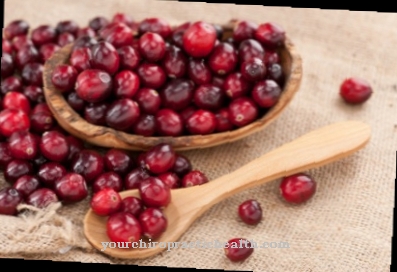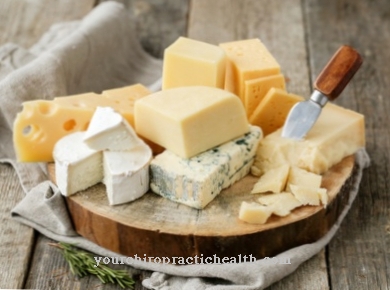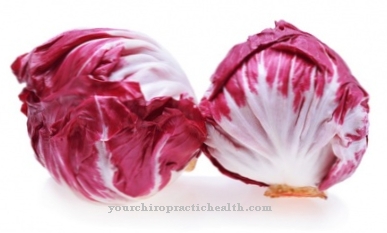The Baker's yeast has its origin in top-fermenting brewer's yeast. Without the yeast you would have to do without many delicacies from the oven, because the dough for cakes or pizza rises quickly and easily.
What you should know about baker's yeast

Baker's yeast is a unicellular fungus that consists of many microorganisms and is able to produce alcohol from sugar during metabolism. The mushroom is only up to ten micrometers in diameter, with a micrometer being a thousandth of a millimeter.
Thousands of years ago, the Egyptians were already using baker's yeast in the production of bread and beer, even if they did not yet know what power was helpful in baking and brewing. The secret was only revealed much later by Louis Pasteur, because he discovered yeast and how it works in 1857 with a microscope. He found out that the yeast is responsible for fermentation. Baker's yeast consists of cells that have cell nuclei. The fungus multiplies through budding. A mother cell forms a protuberance that is equipped with its genetic make-up.
The metabolism of baker's yeast depends on the sugar content of the nutrient medium and the oxygen content of the environment. The waste products of baker's yeast metabolism include carbon dioxide from cellular respiration and alcohol from fermentation. The optimal temperature for fermenting the yeast is 32 degrees Celsius, while it dies at 45 degrees Celsius. Nowadays, baker's yeast fulfills various requirements: It guarantees a very good baking quality thanks to its excellent growing power and shelf life. Furthermore, the baked goods are given a tasty aroma. The amount of yeast is crucial for the taste and freshness.
Importance to health
Baker's yeast also has positive effects in the medical field. It is successfully used, for example, for diarrhea, hair loss and a weak general feeling. Yeast contains many valuable nutrients. The content of B vitamins is particularly impressive, for example vitamins B1, B2, B6 and niacin.
This good mix ensures that the metabolism works smoothly and that the muscles and nerves are supported. Therefore, the baker's yeast is a balm for stressed and tense people. With the folic acid, biotin and pantothenic acid it contains, the yeast also provides true beauty vitamins that ensure healthy skin, hair and nails.
Together with healing earth, fresh baker's yeast is a good face mask, for example. It is even used as a bath additive. In biotechnological processes, it is used to manufacture vaccines, biochemicals and enzymes.
The minerals and trace elements contained are also beneficial, for example potassium, sodium and calcium. The latter ensures strong and healthy bones and teeth. The contained magnesium contributes to supple muscles, the iron is essential for blood formation and the zinc enables good defenses. Thanks to the abundant and high-quality protein, yeast is also an optimal protein supplement for people who have an increased need, for example vegetarians, athletes, pregnant women, breastfeeding women and growing children. Live yeasts also have a probiotic effect, so that they ensure a healthy intestinal flora, act naturally against diarrhea and strengthen the immune system.
Ingredients & nutritional values
Baker's yeast has a lot of biotin, folic acid, various minerals and trace elements such as phosphorus, calcium and magnesium as well as numerous amino acids. Yeast is also rich in high-quality proteins and various important B-group vitamins. Thus, the baker's yeast not only creates a tasty and fluffy pastry, but also improves the nutritional value. Baker's yeast is low in carbohydrates, fat and sodium and contains a lot of protein, fiber and minerals.
Intolerances & allergies
Allergies to yeast are very rare. However, if you get symptoms such as gastrointestinal complaints, nausea, vomiting, diarrhea or a skin rash after consuming food with yeast, you should have a doctor check whether there is an intolerance or an allergic reaction.
Shopping & kitchen tips
Dried yeast is available from discounter or supermarket on the shelf for baking ingredients. Fresh yeast can be found on the cooling shelf, mostly with butter and dairy products. Dry yeast lasts a long time when unopened, making it very useful for stockpiling.
Fresh yeast, on the other hand, only retains its driving force for two weeks in the refrigerator. However, fresh yeast can also be frozen in order to have it available in advance. Fresh baker's yeast guarantees an almost constant driving force until the expiration date, but a cool and dry storage is a prerequisite for this. In addition, the driving force must be stable and must not fluctuate. Uniformity is the most important point when making pastries. Fresh, smooth yeast is shown by its light beige to slightly yellowish color and its pleasant odor.
A brownish color and an unpleasant odor, on the other hand, show that the baker's yeast is covered. The same applies if it looks crumbly. In these cases the yeast should no longer be used. Depending on the recipe, fresh yeast is usually mixed with milk or water. Both should be warm. If the yeast is crumbled with your fingers, it will dissolve more easily in the liquid. Then it is added to the flour and mixed with the remaining ingredients.
Dry yeast is easier to use because it is simply mixed with flour and other dry ingredients and the liquid added separately. The yeast dough will rise particularly well if it is covered with a cloth and placed near the preheated oven. If time is not of the essence and the yeast dough should not be prepared until the next day, the finished yeast dough can also be placed in a cool place and thus rise in the refrigerator.
Preparation tips
Baker's yeast is not, as the name suggests, only used for baking. It is used as a leavening agent to loosen and flavor bread and baked goods. These include, for example, delicious fruit cakes from the tray, snails, bread, rolls, pizza and other delicacies that can be prepared from the yeast dough.
The advantage is particularly evident when baking bread that, thanks to the yeast, even heavy doughs rise optimally and the preparation is therefore relatively quick. Beer, wine and vinegar can also be made with the yeast. Thanks to the baker's yeast and its properties, the food is fermented. In addition, ethanol fuel and cellulose ethanol are obtained from baker's yeast. Through biosorption, the yeast can also filter out heavy metals from waste water, for example copper, zinc, uranium and cadmium. The metal is chemically separated from the yeast.









.jpg)



.jpg)



.jpg)







.jpg)


